With just a few hours of work, youre going to have a freelance portfolio like the ones that earn some of our reader’s thousands of dollars each month.
But freelance portfolios are like snowflakes: No two are alike. A copywriters portfolio wont look like a graphic designers (and vice versa).
BUT there are underlying systems and principles that go into making a good portfolio for any industry. After all, youre building your portfolio to cater to a specific audience of potential clients. That applies to any field.
Follow these basic principles and youll have a freelance portfolio thatll bag you clients.
Step 1: Set up your freelance portfolio website
To create one, you just need two things: A domain name and a website builder.
Domain name
There are many sites out there where you can purchase a domain name. My suggestion: Hover. It has an easy to use interface and provides many affordable domain names.
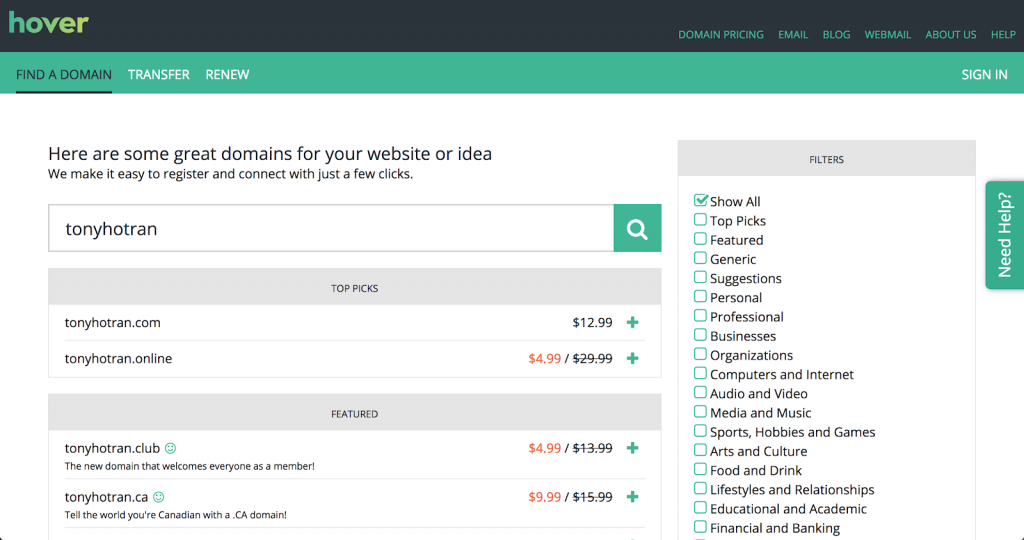
A perfect domain for handsome content marketers.
Just use your regular name for your domain. Later as you get more clients and worry more about your brand, you can revisit your domain name. But for now, your regular name will do.
Here are a few other great options for domain registrars:
- Google Domains. No-nonsense, easy-to-use domain registrar. Prices start at $12 / year for a .com.
- Namecheap. Domains are as cheap as their domain suggest — with some as low as $0.88/year. A .com will run you about $12 / year.
- GoDaddy. A tried-and-true domain registrar. A typical .com there runs for around $12 / year.
Website Builder
Thanks to website builders, you dont need to know a bunch of coding knowledge to create your portfolio.
Though the builder you go with might depend on your goals, I suggest WordPress. Its an incredibly powerful website platform that allows for a lot of customization.
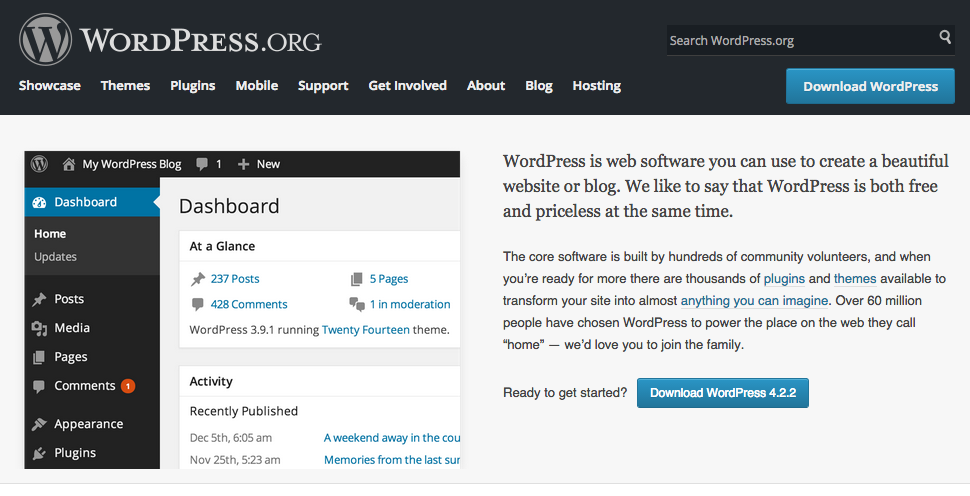
A few other great website builders:
- Wix. Easy to use with a lot of customizable features for your website.
- Squarespace. Good for showcasing images and graphics. Highly customizable.
- Weebly. A ton of great site designs to showcase your portfolio.
For more on creating a website, be sure to check out this article. Once youre done creating it, its time to move on to the next step.
Step 2: Think niche first, then think specialty
Your portfolio is your opportunity to showcase to the world the type of freelancer you want to be even if you dont necessarily have experience.
Lets say you work a regular 9-to-5 job but dream of becoming a freelance writer one day. Your freelance portfolio website should be dedicated to all the work you do as a writer.
Great start. But then you need to niche down your market.
If you want to be a writer, ask yourself: How do I want to position myself as a writer? Copywriter? Content marketer? Blogger? And who are you writing for?
Niche down your specialty and add it to your website. Think about who exactly will be using your services:
- How old are they?
- Where do they live?
- What are their interests?
- How much do they make?
- What books do they read?
And dont worry. If you try something out and dont find its a good fit for you (or your wallet), you can always change your roles. Thats the beauty of freelancing.
Case study: How Brian turned his video hobby into a business
Brian loved to make films so much so that he enrolled in film school. But halfway through he realized he didnt have a clue on how to turn his passion into a profitable business.
He understood the technical and artistic side of filmmaking, but he didnt know how to sell his skills.
So he decided to invest some time into learning how to freelance properly.
Within three weeks, Brian figured out how to turn his hobby into a marketable business: Producing high-end wedding videos. Armed with this knowledge, he set two goals for himself:
- Book three weddings and have one of them be from a couple he didnt know.
- Earn enough to pay for a new camera (about $1,200).
At the beginning, I was pretty much giving the videos away, he recalls. One was free. A couple was $450. By the end of the first season, clients were paying $1,000 for each video. I saw that I was giving people valuable material. They werent paying just to help me out. That meant a lot. They really wanted what I was offering.
He was able to book six clients within a few months. Three of them were people he didnt know!
With each wedding he filmed, he gained a better sense of how many weddings he needed to book in order to turn a profit and how he could better market his hustle.
Nobody else is a full-time wedding videographer in my area, he says. There are some people doing commercial and real estate video. But for now, Im sticking with weddings and doing it better than anyone else. My clients appreciate that, and it makes it simpler for me.
Lesson learned:
Brian niched down his passion of filmmaking into a marketable product of filming high-end wedding videos. By doing so, he turned his hobby into a side hustle earning him thousands of dollars each month.
Once you do the same with your hustle and freelance portfolio, its time to actually put samples of your work online for prospective clients to see.
Step 3: Build out your portfolio (even if you don’t have any “real” work yet)
This is the core of your portfolio. Its your opportunity to show potential clients why youre the right freelancer to hire through work youve already done.
Heres where a beginner freelancer will run into the Job Seekers Paradox. Where are you going to find examples of your work to get clients if youve never had any work?
Here are two areas I suggest going to in order to find samples for your portfolio:
Create new work for yourself.
Maybe youre transitioning to a new line of work. Maybe youre just starting your freelance career from scratch. Theres no reason you cant create new or mock clips to showcase your skills.
Thats exactly what one of our students, Heidi, did when she crafted a fashion design portfolio that helped her break into the industry.
I got my start in the industry because I had Adobe Illustrator on my resume along with the portfolio I created, she says. I finally felt like my dreams had come true. I could say the words Ive wanted to say since I was a little girl, Im a fashion designer.
You can do the same for your industry. For example, if youre a copywriter looking to land nonprofit clients, you might create a 700-word donation email to show your skills.
Really gunning to write for finance blogs? Write a few blog posts based on financial news.
Or maybe youre a graphic designer looking for big-name commercial clients. You might create a flashy ad for Coca-Cola or Nike. In fact, theres a whole community of people who create unsolicited redesigns for just this purpose.
Having work to show at all is much more important than whether or not they come from a job with an actual client.
Do free client work.
Now its an oft-touted rule that if youre good at something, you never do it for free. Im here to say forget that rule.
Instead, reframe: Its totally fine to work for free if youre working for the right people.
The most important thing for you at the beginning stages of your freelance career is for you to build relationships with clients who can open the door to more opportunities. That means you can work for free with people who are trusted and highly networked in exchange for glowing testimonials or referrals to new clients.
The work you show is the work you will get. If you want to do email marketing, showcase stellar emails youve written. If you want to develop apps, link to the apps and software youve created.
Now its time to let people know how to find you.
Step 4: Make it easy to get hired (create a killer call to action)
Your portfolio should always include a place for potential clients to contact you via a call to action. This can be on a separate contact page or something as simple as including your name and email address at the top of the portfolio.
Dont overthink this. Heres a simple template you can use:
If you like what you see here, Id love to work with you. Reach out to me at tony@tonysfreelancingbiz.fake with your inquiry and Ill get back to you soon.
Other things you can include in your contact CTA:
- Name
- Location
- Social media (Twitter, LinkedIn, FB, etc.)
- Phone number
- Address
A good example of this below:
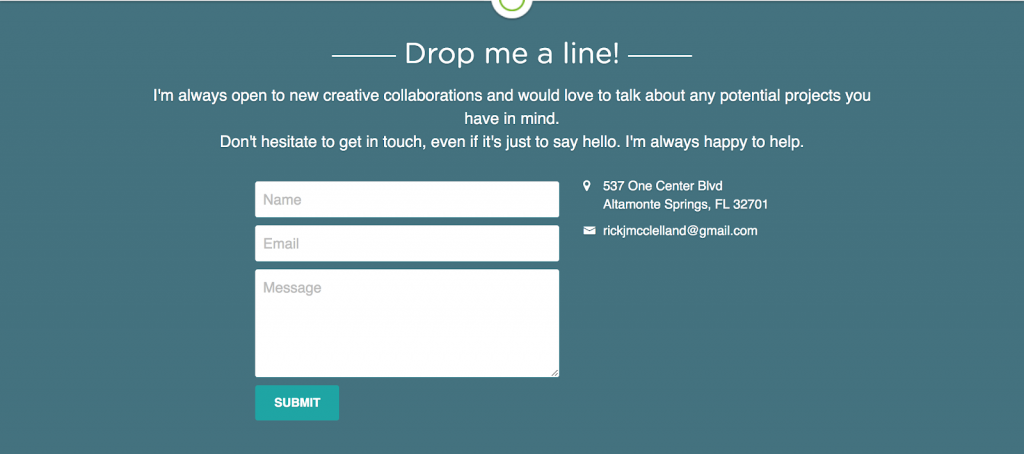
Source: Rick McClelland
Many website builders such as WordPress and Squarespace include extensions that allow you to create your own contact page thatll redirect to your email.
The most important thing is to include your CTA somewhere the client can easily find it. Dont bury it amongst your clips and sample. Just put it at the top of the page or sidebar and youre golden.
…but you don’t have to take the same path as everyone else. How would it look if you designed a Rich Life on your own terms? Take our quiz and find out:
Step 5: Social proof (like testimonials) work, so use them!
This is a completely optional step as your work can speak for itself however, having a positive testimonial on your portfolio can give you the social proof you need to get new clients.
A testimonial is a review from previous clients and people youve worked with endorsing your work. Think of them like the praise you see from other authors on a book cover. And just like your work samples, feature testimonials from the kinds of clients you want again in the future.
If you dont have any testimonials yet, thats okay! Heres an actual email we used at IWT to get a testimonial:
Subj: Can I quote you for my site?
Hey dude,
Thrilled to hear youre doing so well with the company and the new direction.
I was wondering if you could give me a quote that I can use on my website something like:
Ramit completely changed the direction of our business. He re-focused our attention on our users, helped us figure out several lucrative marketing channels, and ripped apart an idea that would have wasted 6 months of our time. His advice will be worth well over $100,000 and that was just over one dinner.
-Mike Jones, Acme Corp
Is that cool?
Thanks,
-Ramit
A few things to note:
- Direct. This email is simple and gets to the point. Dont bog busy people down with things that dont matter. Keep focused on what youre asking them for (note the subject line).
- Friendly. While the message is focused, its friendly. Remember, youre talking to another person here. Thats why Ramit opened with Hey dude. Should you use the same wording? Hell no. But you should keep it casual.
- Easy. Ramit made this easy for the person to say yes by including a pre-written testimonial in the email. All they have to do is give the thumbs up. This improves the chances of them responding positively.
While not 100% necessary, a good testimonial can be a very powerful game-changer for getting clients.
6 Fantastic Freelance Portfolio Examples
Now that you know how to make a great freelance portfolio, its time to take a look at some GREAT ones.
Below are six examples of freelance portfolios from IWT readers. Notice that a few of them bend and break the steps we outlined which is okay! Not all of the elements we talked about above are going to apply to everyone.
The B2B tech writer
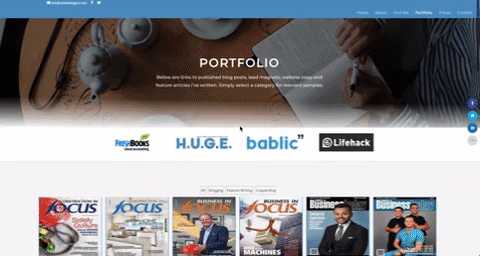
WHO: Nick Darlington
WHAT: Copywriter
WHERE: http://www.nickdarlington.com/portfolio/
This is a great example of a portfolio that clearly showcases a niche. Nick is a writer for B2B publications and that’s shown through his clips and About page. It can be tough for writers to provide visuals for their portfolio but Nick is able to get around that by showcasing the magazine covers that have featured him.
The quirky graphic designer
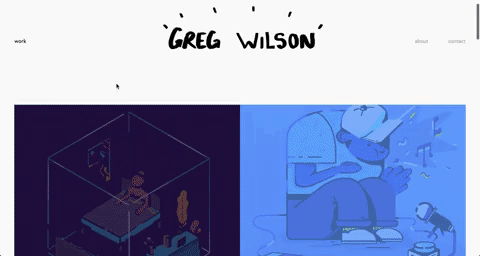
WHO: Greg Wilson
WHAT: Commercial graphic designer
WHERE: https://www.gregwilson.work/about
This graphic design portfolio works exceptionally well by leaning heavily on the visuals that reflect Gregs quirky, off-beat style. Within just a few seconds of scrolling, you know exactly the kind of work and style he produces which is a great thing for prospective clients.
The versatile videographer
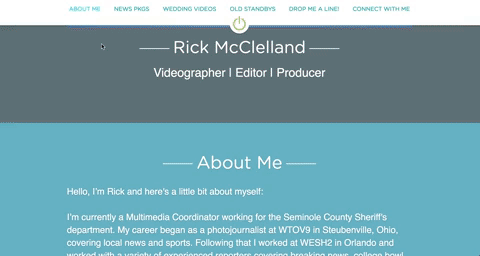
WHO: Rick McClelland
WHAT: News and wedding videographer
WHERE: http://www.rickmcclelland.com/
Rick does something wonderful in his portfolio: He leads with the goods. The first thing you see when you hop into his portfolio is a demo reel of different video shoots he’s done. That’s exactly what you want when you’re a potential client looking for a good videographer. He also ends the page with a great call-to-action for people to contact him.
The front-end developer
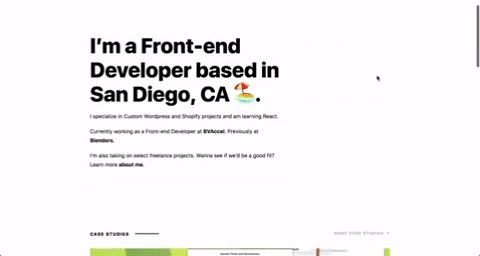
WHO: Adam Rasheed
WHAT: Front-end development
WHERE: https://adamrasheed.com/
Great portfolio that tells you exactly what the freelancer does up top: Adam is a front-end developer based in San Diego. And it goes on to provide case studies of different projects he’s worked on and ends strong with a call-to-action with different ways you can contact him.
The expert tap dancer
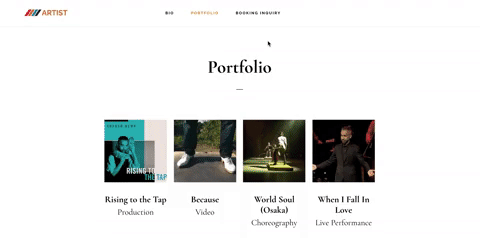
WHO: Andrew Nemr
WHAT: Tap dancer
WHERE: https://andrewnemr.com/
Who says only writers, designers, and developers can be freelancers? Here’s a great example of how the principles for a good portfolio can apply to tap dancing. Andrew showcases his skills by providing links to different videos and performances he’s done. Also, his website is very simple and straightforward.
The marching band leader
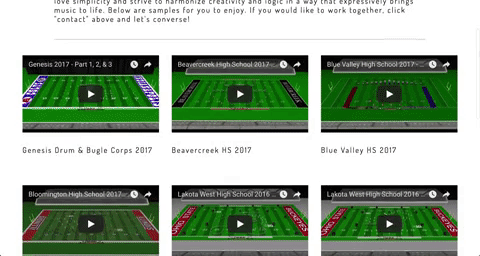
FAQs About Freelance Portfolio
Do I need a portfolio for freelancing?
Clients hire freelancers for specific tasks, and having a portfolio on hand contributes to your professionalism. A portfolio can help solidify your professionalism and show your potential clients that you can deliver their desired results.
How do I get a freelance portfolio with no experience?
To get started in any creative field, you need samples of your work. The easiest path to building a portfolio is to do small jobs for free, in order to hone your skills and build up your experience.
What should be included in a freelance portfolio?
Freelance portfolios are used by freelancers to showcase their work and provide information about themselves. They contain curated work samples, including work done for other previous clients and testimonials from those clients, along with a resume and other professional details. Clients can review this information and decide whether you are the right candidate for their project.
How do I start freelance with no portfolio?
To start freelancing without a portfolio, create sample projects that demonstrate your abilities in your chosen field. Offer your services at a reduced cost or volunteer for organizations to gain experience and feedback. Use these initial projects to build your portfolio. Participating in relevant online communities and contributing to projects can also help you showcase your skills. Building a portfolio from scratch requires effort and creativity, but it’s an important step in launching your freelance career.
If you liked this post, you’d LOVE our Ultimate Guide to Remarkable Content
It’s one of the best things we’ve published, and totally free – just tell us where to send it:
